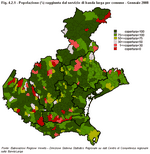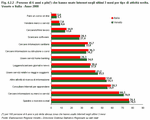4.2 - Virtual mobility
|
Up until now we have spoken about the importance of real mobility, but all of those forms of virtual mobility technological progress have made possible today are equally as important. The ever-increasing use of laptop computers and the newest generation of mobile phones means people can work from home, buy from shops without having to actually go to them, book trips from the comfort of their home sofas, keep up with friends and relatives using email and video calls, manage bank accounts and contact the public administration.
Unfortunately, however, Italy is not yet making the best use of all of these opportunities. A report by the IX Commissione della Camera (9th Commission of the Chamber of Deputies for transport, postal service and telecommunications) on the situation of Italy with regards electronic communications networks shows that Italy lags behind the other EU states in many respects: for the availability of internet access; the connection growth rate; the level of IT skills held by the general population; the number of people who own personal computers; and the development of fibre-optic networks or latest generation technologies. The suggestion is not only to invest in infrastructure but also to encourage a cultural shift towards recognising the value of new technologies and the internet in particular. Infrastructure on its own is not enough to encourage the use of new technologies; these technologies have to become part of the culture, and the population has to be given the means to develop IT skills.
One of the main objectives set by policies regarding this sector is to ensure wider availability of access to new digital technologies and faster connection times. This would help to reduce the digital divide between people who live in areas where advanced services and infrastructure are available (especially ADSL) and those who live in remote areas not yet reached by these services.
Progress has certainly been made: in the second quarter of 2008, Italy registered 10.7 million internet users with broadband access. From 2001 to 2007 ADSL coverage doubled to reach 94% of the population. There are, however, still big differences between the regions and between the urban, suburban and rural areas (99%, 94% and 75% respectively). Only 18% of the population who have broadband coverage actually use it; this is proof of the need to promote and to provide incentives to spread the culture and use of new communications technologies. A survey carried out by Regione Veneto (Note 1) in 2008 on the sixteen main active telecommunications service providers with the aim of analysing the infrastructural digital divide (Note 2) provides information on the state of play in terms of infrastructure and broadband in Veneto. The number of people covered by a broadband connection has increased significantly, causing the digital divide to decrease as a consequence. In 2008, coverage was at 92.4% and the digital divide had halved on the previous year, although on a provincial level variations can still be seen between different areas. (Table 4.2.1), (Table 4.2.2) and (Figure 4.2.1). This progress was achieved thanks to Regione Veneto planning, which set in motion a series of interventions from 2005 on, in direct collaboration with the local administrations, to aid the development of an information society and to guarantee the availability of broadband in areas still caught in the digital divide.
In terms of supply, efforts are being made to make broadband connections more widely available but in terms of demand, the situation seems to be less encouraging. The number of Italians who use a broadband connection is still low: in 2008 a total of 42% of families used the internet (compared to 60% in the EU on average) and only 31% used a broadband connection (compared to the EU average of 48%).
The situation in Veneto does not differ much from the rest of Italy: in 2008 44 families out of every 100 had internet access and in 63.5% of cases this was through a broadband connection (Italian figure: 62.7%). An analysis of the use made of internet indicates, however, that people are starting to utilise the opportunities that new technologies provide for virtual mobility. People in Veneto use the net mainly for sending or receiving emails (76.5%), for seeking goods and services (70.9%), for learning (55%), for research and information (54.1%), for booking holidays (45.5%), for reading or downloading newspapers (38%), and for home banking (35%). (Figure 4.2.2) The use of the net to contact the public administration is also becoming more common, although slightly less so in Veneto than in Italy as a whole. As a matter of fact, 38.4% (Italian figure: 39.4%) of 14-year-olds and over who used the internet in the last 12 months used it to find out information from the public administration, 28.8% (Italian figure: 30.4%) to download forms from public administration sites and 13.4% (Italian figure: 15.1%) to send off completed forms to the public administration. To this regard, it is worth mentioning the memoranda of understanding between Regione Veneto and the Ministero della Funzione Pubblica (the government department for public administration) which calls for a series of key interventions towards the development of e-government. These interventions include the "Reti Amiche Veneto" project, which aims to promote integrated on-line networks that would make it much easier both for the public and for businesses to reach the public administration, and it would also cut waiting times. Figures for e-commerce are slightly higher in Veneto than in Italy as a whole: a total of 31.4% (Italian figure: 29.3%) of 14-year-olds and over who used the internet in the 12 months leading up to the survey had ordered and/or bought goods and/or services on it. |
|
Data processed by the Statistics Office of Regione Veneto are collective property; reproduction of this material is authorised for non-commercial purposes only, provided the source "Regione Veneto - Regional Statistics System Management" is acknowledged.
English translation by the University of Padova Language Centre.







